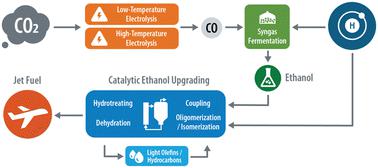当前位置:
X-MOL 学术
›
Energy Environ. Sci.
›
论文详情
Our official English website, www.x-mol.net, welcomes your
feedback! (Note: you will need to create a separate account there.)
Electrifying the production of sustainable aviation fuel: the risks, economics, and environmental benefits of emerging pathways including CO2
Energy & Environmental Science ( IF 32.4 ) Pub Date : 2022-10-07 , DOI: 10.1039/d2ee02439j R. Gary Grim 1 , Dwarak Ravikumar 1 , Eric C. D. Tan 1 , Zhe Huang 1 , Jack R. Ferrell 1 , Michael Resch 1 , Zhenglong Li 2 , Chirag Mevawala 3 , Steven D. Phillips 3 , Lesley Snowden-Swan 3 , Ling Tao 1 , Joshua A. Schaidle 1
Energy & Environmental Science ( IF 32.4 ) Pub Date : 2022-10-07 , DOI: 10.1039/d2ee02439j R. Gary Grim 1 , Dwarak Ravikumar 1 , Eric C. D. Tan 1 , Zhe Huang 1 , Jack R. Ferrell 1 , Michael Resch 1 , Zhenglong Li 2 , Chirag Mevawala 3 , Steven D. Phillips 3 , Lesley Snowden-Swan 3 , Ling Tao 1 , Joshua A. Schaidle 1
Affiliation

|
Due to challenges related to weight and travel distance, the medium to long-haul aviation sector is expected to remain reliant on liquid hydrocarbon fuels into the foreseeable future, representing a persistent source of CO2 emissions within the anthropogenic carbon cycle. As the world grapples with the environmental fallout from rising CO2 emissions, a prevailing strategy to mitigate the impact of air travel is through the utilization of sustainable aviation fuels (SAF) produced from biogenic carbon sources such as fats, oils, greases, and biomass. However, with the demand for SAF expected to grow substantially in the coming decades, there is concern around the availability of these feedstocks at scale. Recent studies have proposed that this potential gap in supply could be closed by utilizing CO2 as a complementary source of carbon combined with renewable electricity to drive the chemical transformation. In this study, a cross-cutting comparison of an emerging CO2-to-SAF pathway with existing routes to SAF is performed, revealing the potential for CO2-derived SAF to be competitive both in terms of costs and carbon intensity, further diversifying future options for SAF and providing a complementary option for the conversion of CO2-to-SAF beyond the decades old methanol to olefins (MTO) and Fischer–Tropsch (FT) technologies. In addition, we discuss potential technical, market, and systems integration risks for the ultimate scale-up and commercialization of the pathway identified herein.
中文翻译:

使可持续航空燃料的生产电气化:包括二氧化碳在内的新兴途径的风险、经济和环境效益
由于与重量和旅行距离相关的挑战,预计中长途航空部门在可预见的未来仍将依赖液态碳氢化合物燃料,这是人为碳循环中 CO 2排放的持续来源。随着世界努力应对不断上升的 CO 2对环境的影响排放,减轻航空旅行影响的普遍策略是通过利用由脂肪、油、油脂和生物质等生物碳源生产的可持续航空燃料 (SAF)。然而,随着未来几十年对 SAF 的需求预计将大幅增长,人们对这些原料的大规模供应存在担忧。最近的研究表明,通过利用 CO 2作为碳的补充来源,结合可再生电力来推动化学转化,可以弥补这种潜在的供应缺口。在这项研究中,对新兴的 CO 2到 SAF 途径与现有的 SAF 途径进行了交叉比较,揭示了 CO 2的潜力-衍生的 SAF 在成本和碳强度方面都具有竞争力,进一步丰富了 SAF 的未来选择,并为 CO 2转化为 SAF 提供了一个补充选择,超越了几十年前的甲醇制烯烃 (MTO) 和费托(FT) 技术。此外,我们讨论了本文确定的途径最终扩大和商业化的潜在技术、市场和系统集成风险。
更新日期:2022-10-07
中文翻译:

使可持续航空燃料的生产电气化:包括二氧化碳在内的新兴途径的风险、经济和环境效益
由于与重量和旅行距离相关的挑战,预计中长途航空部门在可预见的未来仍将依赖液态碳氢化合物燃料,这是人为碳循环中 CO 2排放的持续来源。随着世界努力应对不断上升的 CO 2对环境的影响排放,减轻航空旅行影响的普遍策略是通过利用由脂肪、油、油脂和生物质等生物碳源生产的可持续航空燃料 (SAF)。然而,随着未来几十年对 SAF 的需求预计将大幅增长,人们对这些原料的大规模供应存在担忧。最近的研究表明,通过利用 CO 2作为碳的补充来源,结合可再生电力来推动化学转化,可以弥补这种潜在的供应缺口。在这项研究中,对新兴的 CO 2到 SAF 途径与现有的 SAF 途径进行了交叉比较,揭示了 CO 2的潜力-衍生的 SAF 在成本和碳强度方面都具有竞争力,进一步丰富了 SAF 的未来选择,并为 CO 2转化为 SAF 提供了一个补充选择,超越了几十年前的甲醇制烯烃 (MTO) 和费托(FT) 技术。此外,我们讨论了本文确定的途径最终扩大和商业化的潜在技术、市场和系统集成风险。









































 京公网安备 11010802027423号
京公网安备 11010802027423号